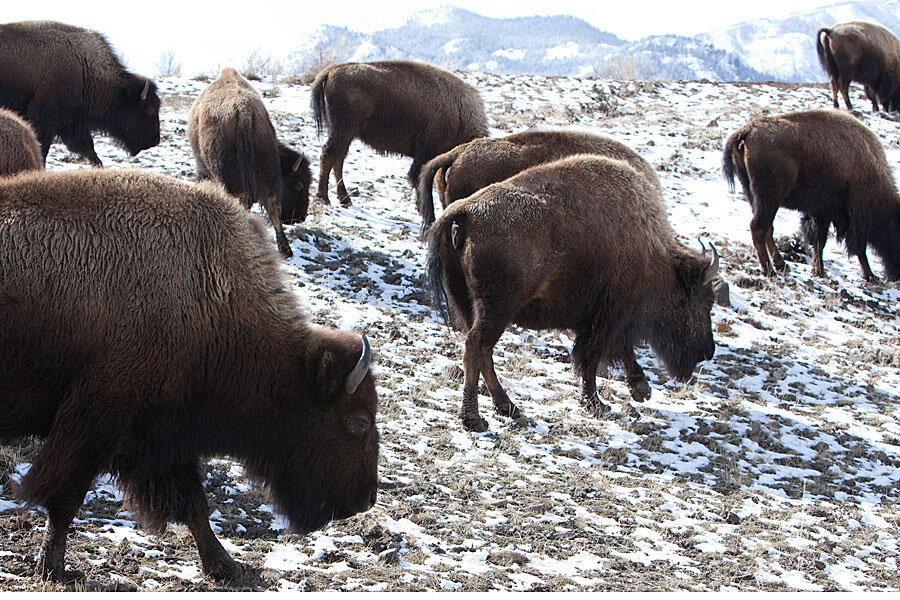Yellowstone bison OK'd to start new herds outside park
Loading...
Wild bison from Yellowstone National Park that are deemed free of cattle disease could be safely used to establish new herds elsewhere across the American West without posing a risk to livestock, a U.S. Department of Agriculture study concluded.
The findings raise hopes of park managers, Native American tribes and wildlife advocates that efforts to restore bison populations derived from the nation's last pure-bred band of wild bison will face less resistance from the cattle industry.
But representatives of cattle producers who have long fought to keep Yellowstone's wild bison, or buffalo, from straying outside the park say their concerns are not entirely allayed by the study.
The research was due to be published in Saturday's edition of the Journal of the American Veterinary Medical Association.
"The study is a valuable contribution to advancing bison conservation," said David Hallac, chief of the Yellowstone Center for Resources, the park's science and research branch.
Bison once ranged by the tens of millions west of the Mississippi until systematic hunting reduced their numbers to the fewer than 50 that found refuge in Yellowstone National Park in the early 20th century.
Today, the more than 4,000 buffalo that roam Yellowstone are a top tourist attraction in the park, which occupies the northwestern corner of Wyoming and spills over into Idaho and Montana. But the iconic animals face capture and death when they wander beyond the park in Montana during winter in search of food.
Roughly half of Yellowstone bison have been exposed to brucellosis, an infection that can cause stillbirths in cows and was introduced to the park by domestic livestock.
Montana's cattle industry, an influential political constituency in the state, fears that straying buffalo will transmit the illness to cows that graze near Yellowstone. That could cause Montana to lose its brucellosis-free status, which allows cattle to be shipped out of state without testing and preserves their market value.
WHERE THE BUFFALO ROAM
Those worries helped shape a federal-state management plan for Yellowstone bison that has allowed thousands to be shipped to slaughter when harsh winters lead them from the snow-covered high country to winter range in lower elevations outside the park in Montana.
The practice has been mired in controversy, a key reason the USDA sought to determine if quarantining bison would keep them brucellosis free, and thus eligible for transplant to Western states beyond the park without endangering cattle.
Three years of experiments conducted on quarantined Yellowstone buffalo by animal disease specialists with the USDA and a scientist from the nonprofit Wildlife Conservation Society show that culling out bison calves exposed to brucellosis can make for a disease-free herd.
"The key conclusion is that it's feasible for us to take bison from Yellowstone and make them eligible to be used for restoration," said the society's Keith Aune, a co-author of the study. "They are a very important source of genes that harken back to the ancient DNA of North American bison."
The restoration in the past two years of Yellowstone buffalo to their historic range on Indian lands in Montana has been celebrated by tribes but resisted by ranchers worried about disease, competition for grass and property destruction from straying bison.
Jay Bodner, natural resource director for the Montana Stockgrowers Association, said fears of disease are lessened but not eliminated by the study.
The findings show no persistent infection in the quarantined bison, but that doesn't rule out latent infections, he said.
"There are still qualms in the livestock industry. Certainly, there are management concerns. How many bison on the landscape are enough? How do you contain animals that can walk right through most fences?" he said.
Robert Magnan, head of the fish and wildlife department for the Sioux and Assiniboine tribes in northeastern Montana, oversaw the return in 2012 of 60 wild buffalo to their homeland on the Fork Peck Indian Reservation.
The landmark restoration, fought by ranchers, symbolized a new hope to an ancient people whose cultural and religious practices were intertwined with vast buffalo herds that were all but extinct by the late 19th century, he said.
Magnan said the research will open the way for Fort Peck and other reservations to claim healthy Yellowstone bison marked for slaughter.
"We look at them as our relatives," he said. "They took care of us for hundreds of thousands of years. Now the shoe's on the other foot. It's time we stand up and help them."
(Editing by Steve Gorman and David Evans)





